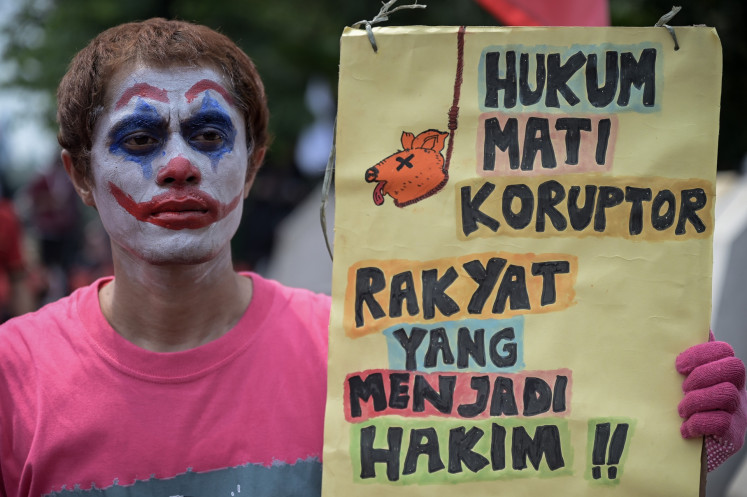Popular Reads
Top Results
Can't find what you're looking for?
View all search resultsPopular Reads
Top Results
Can't find what you're looking for?
View all search resultsChoosing to dance
Footloose: Dancers in the Indonesian Dance Festival (IDF) choreography workshop practice their moves
Change text size
Gift Premium Articles
to Anyone
F
span class="caption" style="width: 468px;">Footloose: Dancers in the Indonesian Dance Festival (IDF) choreography workshop practice their moves.When told to sit down on the tile floor, several of the participants at the 11th Indonesian Dance Festival’s choreography workshop last month grimaced as they let their bodies down slowly.
“This is tiring. I have never gone through anything quite like this before,” Nila, one of the participants from Labuan Bajo, East Nusa Tenggara, said. She was among the few who appeared to struggle a little to walk.
Nila had traveled along with a fellow dancer and several of their teachers from the group “I” Production’s West Manggarai chapter to Indonesia’s capital for the workshop.
The one-week training proved to be an enriching and challenging experience.
The participants’ activities usually began as early as 8 a.m., when they learned physical techniques and about supporting elements of dance such as music and stage equipment, as well as theories and concepts of choreography.
After a lunch break, the workshop continued with mentoring and collaborative activities, and at night participants had to present their choreography to their mentors and guides as well as engage in discussions about their work. Their days typically ended at around 10 p.m.
“I” Production founder Andi Tenri Lebbi said that the workshop was actually slightly too sophisticated for Nila and her friend Yuni, who were still in junior high, because it included composing choreography and the girls were still novice dancers.
Nevertheless, the group brought them along because they saw it as a good step forward in their effort
to keep up with developments in other regions. “[The young dancers] can be called seeds of choreographers,” she said
Nila, who joined the group less than a year ago, said she first became attracted to dance when she saw performances by pop star Agnes Monica.
Although she was previously never chosen for any special activities in her school, joining the group brought her certain successes, including traveling to Jakarta. Her parents thus support her dancing. “They were surprised because I was able to travel far from my hometown [because of dance],” she said.
While Nila said she hoped to become a professional dancer in the future, Yuni said she was planning to make dancing a side activity, especially if she can find a job in another field.
But, Southeast Asia’s largest economy has apparently been paying more attention to the entertainment and creative industry lately.
It recently replaced its Culture and Tourism Ministry’s name with the Tourism and Creative Economy Ministry, and despite the recent cancellation of US pop diva Lady Gaga’s concert, Indonesia has hosted a myriad of solo performances and festivals this year.
However, dedicating one’s life to art, including dance, might still be viewed as a risky choice for some, especially in terms of financial security.
Several of the participants in the dance competition and choreography workshop said they mostly relied on events, such as traditional ceremonies and product launch events, for their income as dancers. Other career prospects include teaching. Yet, financial constraints can be a challenge even before an artist establishes his or her career.
According to Indonesian Dance Festival (IDF)’s Nungki Kusumastuti, the festival’s first-ever dance competition was met with more responses than expected, with over 100 groups from various parts of the country sending their videos to be judged. One of the groups came all the way from Pontianak, Kalimantan, to compete in the finals.
But several of the participants in the competition, for example, failed to make it to Jakarta for the finals because they could not afford the transportation cost, Nungki said.
“There were 33 [participating groups] that were considered good, but only 27 can make it to Jakarta. Apparently they still needed funds to come to Jakarta but it wasn’t enough so they withdrew from the competition,” she said.
“I” Production’s Tenri said it was still unlikely that someone in Labuan Bajo could make dancing their living because the art is still yet to be viewed as having a promising market, with even traditional dances like the ndudundake losing popularity among the young. “Even asking dancers to join is hard, it takes an amount of coaxing,” she said.
But she sees hope in the growing spotlight on nearby Komodo National Park, which was recently named one of the seven wonders of nature by The New 7 Wonders Foundation. The region also broke two local Indonesian Records Museum (MURI) records last year by holding a mass ndudundake dance event involving over 2,000 locals.
But at times, it is more than just the money, or lack of it.
Beni Satria, a participant from Natuna, Riau, said that people in his hometown still had certain stereotypes regarding dancing men, who are often associated with bencong or ladyboys. “Some of my friends ask me ‘are you a man or a bencong?’,” he said.
Although some of the men who dance are indeed perhaps feminine, he said, “basically it all depends on the person.”
Beni said he was first introduced to dancing in 2002 when he was still in high school. “The school asked us to perform for an event and at first I felt really forced to do it… especially because I found the traditional dances to be very feminine,” he said.
Like most of his friends back then, he said he was distanced from the art and local tradition in general. Yet the experience intrigued him and made him realize just how far local youths have stepped away from tradition.
Beni then decided to join a dance group, and even founded his own group, Dina Mahkota, with some friends. “To me, dancing is a way to express my feelings,” he said.
A participant from East Java, Ferry Cahyo Nugroho, said he first faced silence from his parents regarding his choice to take up dancing as a major at Malang State University. “I didn’t know what was in [my parents’] minds then,” he said.
At first, he was more interested in music, but the campus didn’t provide that particular major. And although he found it awkward to dance at first, he became more and more intrigued by the subject because, according to him, it comprises a number of dimensions including theater, music and visual arts.
His parents have begun to be interested in his career as well, Ferry said.
“Lately, they began to talk about my future plans. [They said] ‘You better do this and that, when you return [to your hometown] you should be a teacher, and form a group.’ They began to motivate me,” he recalled.
All the right moves: Stretching is an integral part of a dancer’s life.Ferry added that he is considering applying for a job in the education agency in his hometown, Magetan, East Java, to improve the agency’s arts education, which he said is still lacking in competitiveness.
The workshop, which he found through browsing the Internet, will hopefully help him find his own style and skills, because he said he realized he was still “weak” in both traditional and modern dance.
The workshop gave him more interpersonal experiences and challenges as well, especially in teaming up with people from various ages and regions in the archipelago to create choreography. “It is still hard to let go of our egos,” Ferry said.
Although he said he realizes working in the arts field might be a challenge, he believes that one’s hard work will eventually pay off.
“When I dance, it is like I am performing a prayer. And that’s what I keep in mind. To me, dancing is a form of ibadah [religious worship],” Ferry said.











